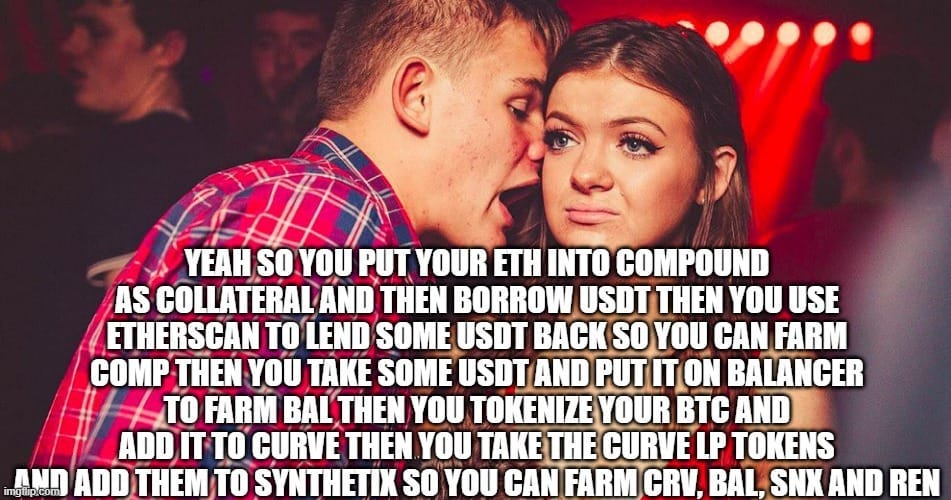Welcome Avatar! One of the criticisms of DeFi is that the industry is simply copy pasting the traditional finance system with a web interface. Instead of going to a bank to get a loan, you click on a couple of buttons and secure a *collateralized* loan. This is the most common type of loan (put in some crypto, acquire some stables). Over time, the industry needs to move forward and start offering products that are not currently available in the traditional financial market. Otherwise the industry is doing the same thing that Wall Street does… copy other ideas.
Part 1 - What DeFi Can Do Better
We’ve already covered why DeFi is better from a cost perspective relative to the traditional financial system. 1) using software code reduces overhead - real estate not needed, tons of employees and even the computers and air-conditioning systems; 2) speed is significantly higher as it can take a month or more to secure a large loan and 3) it opens up a global market vs. a a national market.
If we look at the product offerings? They admittedly need some work. First? We have to walk through some of the ways DeFi can improve its competitive positioning against the traditional financial system.
#1 Better Rates: With a global market that is peer to peer, you should expect better rates both for lenders and borrowers over the long-term. Currently if you wanted to borrow a large sum of money (say six-figures or more), you have to go from institution to institution and eventually get the best rate available. This can be made more efficient through basic platforms that recommend 3-4 banks that offer the best rates for your financial needs.
Fast forward. If we look at the future, social credit scores should allow you to get “better” rates. Better is in quotes because if you’re a wealthy person with high integrity, people should offer you a better deal and you should be able to be more picky about who you associate with. This is already occurring today. People already send money to individuals they have never met (due to long interactions online). Just scale this up to loans.
Conclusion: over a long time horizon rates should improve for individuals. Everyone is a “bank” which means that anyone can loan or borrow which is a lot better than working with 3-4 institutions.
#2 Variable Pay-down Mechanics: If you have ever taken out a 30-year mortgage (or any mortgage), you know that there are various rules and stipulations associated with them. Sometimes you may be marked as a “jumbo loan” (different rate), sometimes there is a “pre-payment penalty” if you pay it off too quickly and sometimes there are higher/lower rates based on the classification of the home (condo/townhome etc.).
Since contracts are made with code you can now imagine a lot more complex/wider range of options. For example: you could have a 10-year loan with specific periods where you can pay *more* of the loan without penalties. Say at year three you have an option to pay it off entirely or pay off X%. These “windows” can pop up automatically and close within say 7 days.
Conclusion: instead of copying conventional and some basic non-conventional loans, you can create new payback methods that are not photo copies of traditional finance.
#3 Cross Asset Lending/Borrowing: Another benefit of doing loans with code is that you can have a cross asset conversion in the future. Most products such as a convertible bond only relate to a single asset (say Company ABC stock). This makes sense if a company is issuing a bond but does it make sense if you are the one looking to borrow money? Unlikely.
Instead of locking in ETH/BTC, in the future you should be able to create contracts that are related to other assets. For example, you could borrow US tokens (stables) but you could put up a *basket* of your assets! This is a big deal as it should theoretically lead to lower borrowing rates. If someone backed their loan with 100 shares of S&P 500, 100 shares of Tesla, 5 BTC and 10 ETH, that would probably be more attractive than a loan backed by just Tesla or just BTC even if the total US token value was the same.
Conclusion: you can turn all your assets into a basket (similar to an ETF) that should be viewed as lower risk and offer new interest rates.
Overview: While we’ve only touched on three clear items: 1) better rates; 2) newer paydown/loan agreements and 3) cross asset loan agreements the common thread is clear: DeFi offers more options/open doors. While speed is well known (click a few buttons to gat a loan), individuals are underestimating the value of higher competition and options.
Part 2 - What DeFi Needs to Fix
While we could go on and on about the benefits and pump our own futures here, we have to take a step back and look at the major issues at this time.
#1 Terrible Tokenomics Information: Every single day you see a new ponzi pop up. People are more interested in chasing the next shiny object than anything else. In fact, most users don’t even understand what a vesting schedule is, what an “unlock” is or how slippage works on a book.
A good way to solve this is by having a clear link to the tokenomics/vesting for each coin so before you decide to farm scam coin number 69, you can at least see when the market will likely dump.
#2 Centralized Projects: Vast majority of all projects are heavily centralized. We still get emails suggesting that the “returns on stables are risk free” and this belief is disturbing at minimum. Most DeFi projects can go down, get rugged and be blocked similar to how USDT can freeze funds.
#3 User Interface: User experience with DeFi and crypto in general isn’t great. Not going to be easy for anyone over the age of 40 or so to learn how to move around from chain to chain. It is hard enough to manually look around for the correct rate for a swap and a lot of people just use the built in Metamask feature despite the higher cost of doing so.
We’re more than happy to say that this type of process is not “normal person friendly”. Too many clicks and too many transactions to check where it is possible to sign incorrectly.
Part 3 - Futuristic DeFi Products
If you expand the definition of decentralized finance (from tons of ponzis and a few real projects), you can see how integrating smart contracts into financial services is cost effective.
#1 Insurance: If you’ve ever had to deal with claims, you know that it can take weeks/months to reach a resolution even if you already paid for the insurance. Imagine a world where instead of dealing with people, you’d have sensors and images that instantly deliver funds to the right party. We realize Nexus Mutual is working on insurance, however, this example would be for real world applications: insurance on a home where images could instantly see a earthquake decimated the building. Faster payout and lower overhead as no one needs to walk through with paperwork to “prove” it occurred. Note: there is a negative here as it suggests more surveillance.
#2 Complex Declining/Increasing Interest Rate Instruments: While variable interest rates exist, if you look at the cost of doing business it is quite high. Rates change and the mechanics of the loan change. In a more cost effective environment (software code), you could create more complex interest rate mechanisms.
For example, if the size of the loan changes rates can change instantly. If the collateral put up changes, the rate can change instantly… You could even create a rate change based on who takes the loan - IE if it’s a DAO and the head of the DAO leaves, the rate could change! Big Picture: since loans are just software code you can create baskets of variable and changing loan requirements without complicated paperwork that 7-9 people need to sign off on every single time.
#3 Fractionalized Lending and Selling: People won’t be degenerate enough to own 10% of a punk 10% of an Azuki, 5% of a BAYC and create a collateralized package to borrow against will they? Sure they will. This is crypto so it means the most aggressive and craziest ideas will be thrown out there.
Eventually, we need to move to a point where it is easy to transfer loans (trade all of them). If someone lends address A 100 ETH and it pays out X%, this loan should have the ability to be transferred with ease in a clean and simple market place. Right now even if you want to buy out liquidations it really isn’t easy (at least for a normal user).
Now that you have an understanding of how the financial services industry is going to be eaten by code, it’s probably a good idea to subscribe to the more in depth analysis we put together. Besides… We’re a top 5 newsletter in crypto and no one knows who we are (we don’t even know each other!). Building credibility from scratch sure is harder than hiding behind fancy Harvard Degrees. Equal Opportunity, Unequal Results.
Until next time…
Disclaimer: None of this is to be deemed legal or financial advice of any kind. These are opinions from an anonymous group of cartoon animals with Wall Street and Software backgrounds.







More important than decentralized is "permission-less". Ignoring the updateable smart contracts like Solana, once the contract is out there, and admin rights revoked, it doesn't matter as much if the front-end is a centralized operation. Worst case, fork the code.
Can we get a Tokenomics for Dummies post or series? Cobie had a good article on this recently. Scott Adams talks about “confusopoly” where marketing is designed to prevent the buyer from making informed decisions. Unfortunately that’s where a lot of tokens are: an incredibly intricate mishmash of vesting schedules for half a dozen interested parties.
This comes across as being designed to rug retail and then blame retail investors for not “doing the research”. When the project knows full well that they wrote the documentation to be as opaque as possible.
It’s a terrible look for a young industry still needing to attract positive attention. Bad tokenomic setups need to be explained and addressed aggressively from within the industry. Or regulators assuredly will address it, and it’s likely that real innovation will get strangled in the process.